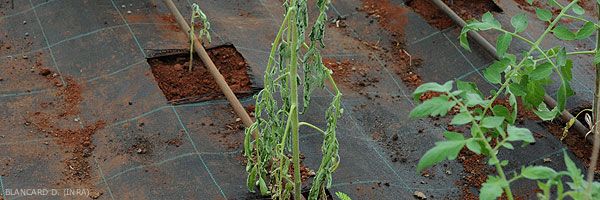
(Smith, 1896) Yabuuchi et al. , 1996
- classification : Bacteria, Proteobacteria, Beta proteobacteria, Burkholderiales, Ralstoniaceae
- synonyms: Burkholderia solanacearum (Smith, 1896) Yabuuchi et al. , 1993
Pseudomonas solanacearum (Smith, 1896) Smith, 1914
- English name: bacterial wilt
Ralstonia solanacearum occurs mainly in tropical, semi-tropical and warm temperate regions . It is severely rife in many countries of Asia (China, Japan, Malaysia, Philippines, Pakistan, Thailand, Vietnam, India ), America (United States, Mexico, Brazil, Argentina ) and d 'Africa (both north and south). This bacteriosis is now well established in Europe: the cold tolerant strain (Phylotype IIB-1 historically race 3 biovar 2) has been reported there in the majority of member countries including the Netherlands, Belgium, Germany, the Great -Brittany, France, Italy, Spain, Greece ...
In France , this bacteriosis is particularly harmful in the overseas territories in Guadeloupe, Martinique and Guyana in particular. A few rare attacks of bacterial wilt have been observed very occasionally in metropolitan France, mainly in crops under cover above ground.
Ralstonia solanacearum is a soil-borne Gram-, polyphagous bacterium with worldwide distribution , and extremely feared by tomato growers where it is prevalent. Its great variability is explained by the existence of several strains, which differ in particular by their ability to metabolize various sugars and denitrify nitrates, as well as by their distinct host spectrum. Thus, R. solanacearum is historically classified into 5 physiological races (no taxon value) and 6 biovars:
- race 1, comprising many strains isolated in regions and on various hosts; it would be known like the race of the Solanaceae, infecting the potato, the eggplant, the pepper, the tobacco, the tomato ;
- race 2, adapted to triploid bananas in tropical areas;
- race 3, attacking preferably the potato, the tomato, weeds belonging to the Solanaceae family, in temperate conditions;
- race 4, based on ginger;
- race 5, affecting the mulberry tree.
Recently, a phylogenic analysis based on different molecular approaches showed that this bacterium should be appreciated as a complex of species belonging to 4 phylotypes linked to strains of different geographical origins: Asiaticum (phylotype I, ex biovars 3, 4 and 5 and ex races 1, 4 and 5), Americanum (phylotype II, ex biovars 1, 2 and 2T and ex races 1, 2, 3…), Africanum (phylotype III, ex biovars 1 and 2T and ex races 1, 3) and Indonesium (phylotype IV, ex biovars 1, 2, 2T and ex races 1, 3).
The tomato is therefore susceptible to attack by various lowland tropical strains ( lowland ) which fall into the 4 phylotypes (historically race 1), and by temperate cold tolerant ( strains highland ) of phylotype IIB-1 (historically race 3 ). This latter group of strains (phylotype II) could allow R. solanacearum to emerge in temperate tomato growing areas, unlike tropical strains.





